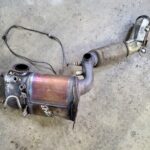Experiencing engine trouble can be stressful, especially when your car isn’t performing as it should. One common issue signaled by your vehicle’s onboard diagnostic system is a cylinder misfire. Specifically, if you’re seeing the error code P0301, this indicates a misfire in cylinder 1. But what exactly are Cylinder 1 Misfire Symptoms and why is it important to address them promptly? This guide, brought to you by the automotive experts at obd-de.com, will break down everything you need to know.
A cylinder misfire occurs when one of your engine’s cylinders fails to combust fuel and air properly. In simpler terms, cylinder 1 isn’t doing its job to contribute to the engine’s power output. This can stem from various underlying problems related to fuel delivery, ignition, or compression. Recognizing the symptoms early is crucial to prevent further engine damage and costly repairs.
Common Symptoms of a Cylinder 1 Misfire
Identifying a cylinder 1 misfire early can save you from more significant car troubles down the road. Here are the primary symptoms to watch out for:
Check Engine Light Illumination
The most immediate and obvious sign of a cylinder 1 misfire is the illumination of your check engine light. When the engine control module (ECM) detects a misfire, it triggers this warning light on your dashboard. While the check engine light can indicate various issues, it’s always the first signal that something is amiss and requires investigation. Don’t ignore it; use an OBD-II scanner to check for error codes, specifically P0301.
Rough Idling and Vibrations
A misfiring cylinder disrupts the smooth operation of your engine, leading to a rough idle. You’ll notice this symptom most prominently when your car is stationary, such as at traffic lights or in park. The engine may vibrate excessively, feel shaky, or run unevenly. This is because the engine isn’t firing on all cylinders, causing an imbalance in its operation.
Noticeable Lack of Power and Sluggish Acceleration
When cylinder 1 misfires, your engine loses a portion of its power. This translates to a lack of power and sluggish acceleration when you press the gas pedal. Your car might feel hesitant to accelerate, especially when starting from a standstill or when trying to overtake on the highway. This reduced performance is a direct consequence of the engine not producing its full power output due to the misfiring cylinder.
Decreased Fuel Economy
A cylinder 1 misfire can negatively impact your car’s fuel economy. When a cylinder misfires, unburned fuel is often sent into the exhaust system. Your engine has to work harder to compensate for the misfiring cylinder, consuming more fuel in the process. You might observe that you’re filling up your gas tank more frequently than usual, or that your MPG (miles per gallon) has decreased noticeably.
Engine Hesitation and Stuttering
Engine hesitation or stuttering during acceleration is another common symptom. This occurs when the misfire is intermittent or becomes more pronounced under load. You might feel your car jerk or stumble as you accelerate, especially at lower speeds. This hesitation is the engine struggling to maintain smooth power delivery due to the inconsistent firing of cylinder 1.
Smell of Unburned Fuel
In some cases, you might detect the smell of unburned fuel coming from your exhaust. This is because the misfiring cylinder is not combusting the fuel properly, and the raw fuel is being expelled into the exhaust system. This symptom is often more noticeable when the misfire is significant and persistent.
Diagnosing and Repairing a Cylinder 1 Misfire
If you experience these cylinder 1 misfire symptoms, it’s essential to diagnose the root cause accurately. Common culprits include faulty spark plugs, ignition coils, fuel injectors, or compression issues within cylinder 1.
A mechanic will typically use an OBD-II scanner to confirm the P0301 code and then perform further diagnostic steps such as:
- Visual inspection of spark plugs, ignition coils, and wiring.
- Compression test on cylinder 1 to assess cylinder health.
- Fuel system check to evaluate fuel injector function and fuel pressure.
Repairing a cylinder 1 misfire can involve replacing worn spark plugs or faulty ignition coils, repairing or replacing malfunctioning fuel injectors, or addressing any compression problems. Prompt and proper repair is crucial to restore engine performance, fuel efficiency, and prevent potential damage to the catalytic converter and other engine components.
Is it Safe to Drive with Cylinder 1 Misfire Symptoms?
While technically you can drive your car with cylinder 1 misfire symptoms, it’s strongly not recommended. Continuing to drive with a misfire can lead to:
- Catalytic converter damage: Unburned fuel can overheat and damage the catalytic converter, a costly component to replace.
- Increased engine wear and tear: Misfires put extra stress on other engine components, potentially leading to more serious and expensive problems.
- Worsening misfire: The underlying issue causing the misfire can worsen over time, potentially leaving you stranded.
It’s always best to address cylinder 1 misfire symptoms as soon as possible. If you suspect a misfire, have your vehicle diagnosed by a qualified mechanic to ensure safe and reliable operation.
For further information on diagnosing engine trouble codes, you can explore our comprehensive OBD-II trouble code directory. Understanding cylinder 1 misfire symptoms is the first step towards getting your car back in top shape and ensuring a smooth and efficient driving experience.
